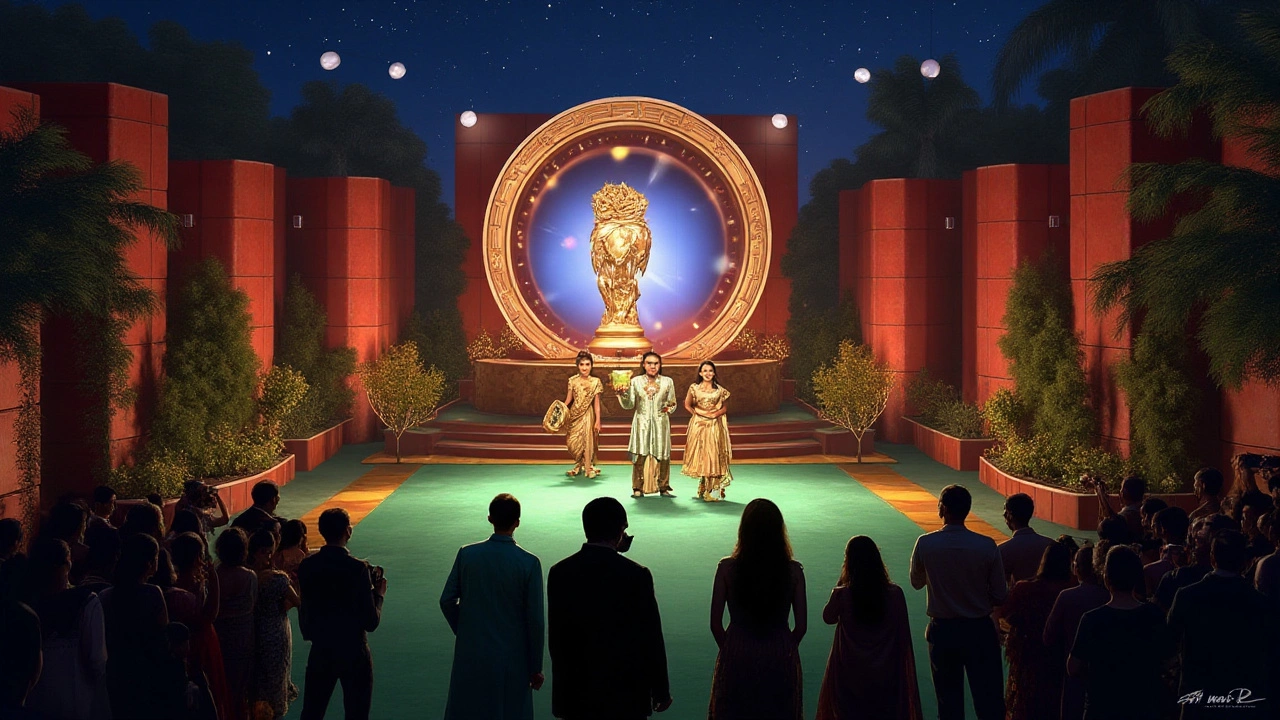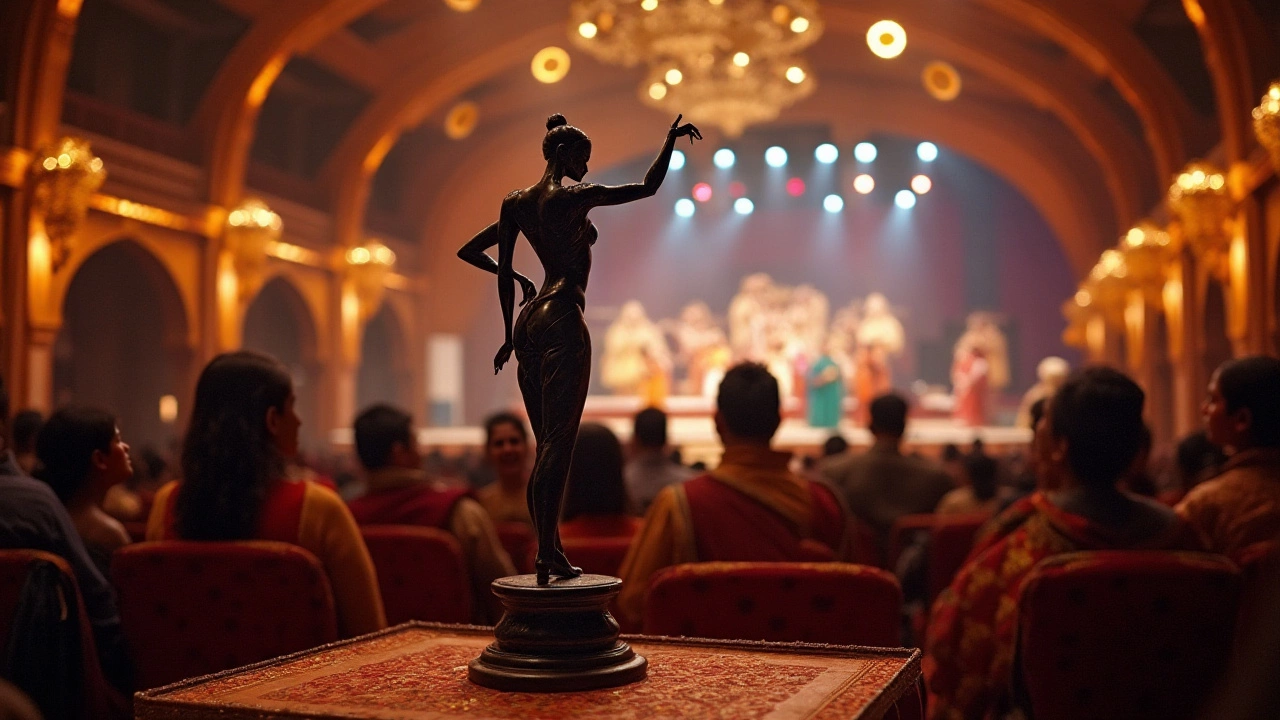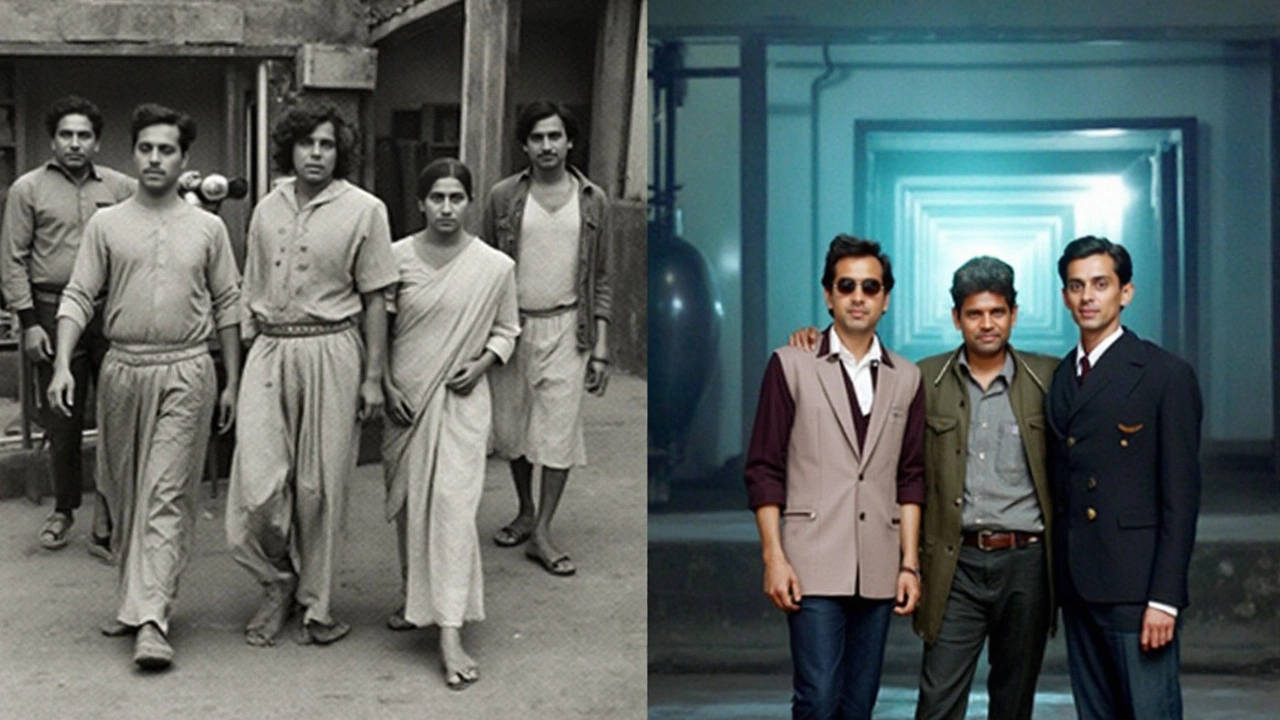Understanding the Key Differences Between IIFA and Filmfare Awards
 Jan, 23 2025
Jan, 23 2025
The Indian film industry is immensely rich with colorful stories, electrifying performances, and stirring music. To celebrate this vibrant cinema, several prestigious awards are hosted annually. Among these, the International Indian Film Academy Awards (IIFA) and the Filmfare Awards stand out, each bringing its unique flair to the table.
As the glitz and glamour unfold, many fans often wonder what sets these awards apart and as such, this article aims to shed light on how IIFA and Filmfare diverge, covering various perspectives like their origin stories, judging processes, and the mark they leave on Indian culture. So, if you've ever found yourself watching these grand events with a sense of curiosity, join us as we unravel the intricacies of each, providing a clearer picture of their role in honoring Indian cinema.
- History and Origins
- Selection Process and Jury
- Cultural Impact and Significance
- Event Organization and Scale
- Audience and Industry Perception
History and Origins
The tapestry of Indian film awards is woven with a rich history, and at its heart lies two major events: the International Indian Film Academy Awards, or IIFA, and the Filmfare Awards. Both awards hold significant spots in celebrating the brilliance of Indian cinema, but their origins tell stories as distinct as the films they honor. The Filmfare Awards were first introduced in 1954, marking the dawn of an era where cinematic achievement began to be recognized on a grand scale. Heralded by The Times Group, these awards mirrored the glamour and drama of the Oscars, aiming to celebrate the art of motion pictures in a manner relatable to Indian audiences.
IIFA, on the other hand, made its grand entrance several decades later. In 2000, the concept of taking Indian cinema to new horizons birthed the idea of the IIFA celebrations. Its launch was not merely about acknowledging cinematic brilliance but also served as a global ambassador of sorts for Bollywood, showcasing Indian talent on international soil. Since then, IIFA has dazzled fans worldwide with ceremonies held in exotic destinations like London, Dubai, and Macau. The awards quickly became more than just a ceremony; they turned into a spectacle charged with the energy of cross-cultural exchange, drawing global audiences into the vibrant world of Indian cinema.
This divergence in timelines is not just chronological; it reflects differing philosophies behind each award. Filmfare, with its deeply rooted connection to the Indian public, has grown to become a household name, often seen as a barometer of both popular and critical acclaim within India. Alternatively, IIFA has embraced its mission to go beyond borders, fostering a diplomatic charm offensive that seeks to place Indian films on an international pedestal. As stated by former IIFA host Amitabh Bachchan
"IIFA not only celebrates Indian cinema but also helps to build global bridges". This commitment to spreading Bollywood's influence worldwide is part and parcel of what makes IIFA distinct.
The stark differentiation between Filmfare and IIFA does not end with their initial intentions. It's encapsulated in the environments they create. While Filmfare enjoys the prestige of being a beloved tradition held in India annually, IIFA's nomadic nature ensures it brings a slice of Indian artistry to myriad cultures around the globe each year. The results are twofold: fans outside India relish a touch of Bollywood magic, while the domestic audience revels in a feeling of international recognition. Both awards, while distinct in their birth and purpose, play pivotal roles in carving out the narrative and journey of Indian films as they continue to capture hearts both at home and abroad.
Selection Process and Jury
The journey of acclaim and recognition begins long before the awards night, unfolding behind the scenes with meticulous attention to detail. The International Indian Film Academy Awards (IIFA) and the Filmfare Awards, both being giants in the realm of Indian cinema acknowledgments, have distinctive processes when it comes to selecting and nominating talent. At the core of these processes lies a careful balance of expertise and popularity, aiming to celebrate both critical excellence and audience favorites.
The Filmfare Awards, established in 1954, boast one of the most transparent and inclusive methods. The nominations are divided into two main categories: the Critics' Awards and the Popular Awards. For the Critics' Awards, a panel of seasoned experts in the film industry is responsible for nominating and selecting winners, placing emphasis on artistic and technical brilliance. This jury includes veteran actors, directors, and film critics, ensuring a well-rounded consideration of Indian cinema's offerings. In contrast, nominations for the Popular Awards depend significantly on voting by the public, culminating in a unique blend of expert opinion and widespread public sentiment.
On the other hand, the IIFA, which began in 2000, takes the popularity contest to a global fan base. Its selection process is primarily driven by fans, who play a critical role in nominating and voting for their favorite stars and films. This encourages a significant involvement of the international Indian diaspora, further strengthening the outreach of Indian cinema worldwide. Despite the fan-centric approach, IIFA also leverages the expertise of industry professionals to shortlist nominees before opening up to public voting. This dual-layer process is essential to maintain a balance between popular votes and industry recognition.
Key Differences in Jury Composition
The jury composition is a notable distinction between these awards. Filmfare relies more heavily on its panel of distinguished artists and critics for critic categories, while IIFA places more trust in the global audience's voice, with industry inputs mainly limited to initial shortlisting. Each approach offers a unique flavor and has its own set of advantages and challenges. Filmfare's critical jury ensures that even the smallest gems of cinema, which may not achieve blockbuster status, get the acknowledgment they deserve, especially in technical categories like Best Editing or Sound Design.
"The power of a thriving film industry lies in its ability to reward creativity while acknowledging viewer preferences. Both IIFA and Filmfare have crafted their jury systems with an acute awareness of this balance," remarked noted film critic Anupama Chopra. Her insights emphasize how each award show serves different, yet complementary, functions in recognizing Indian cinematic achievements.
Noteworthy is the extensive voting process in IIFA, which uses digital platforms to engage with audiences across continents, a feature perfectly tailored for the digital age. Meanwhile, Filmfare’s long-standing reputation as a household name in India allows it to attract massive participation through traditional media outreach, adding diverse voices to the mix.

Cultural Impact and Significance
In the captivating world of Indian cinema, the IIFA and Filmfare Awards hold a profound cultural impact that transcends mere accolades. They have grown to embody much more than just recognition of talent and craftsmanship; they are emblematic of the dreams, aspirations, and storytelling that unite diverse audiences worldwide. The Filmfare Awards, first held in 1954, are a testament to Bollywood's legacy, grounding themselves in nostalgia and the evolution of Indian cinema through generations. With each glamorous evening, they reflect the changing tastes of cinema-goers and signal trends that sometimes travel beyond national boundaries, influencing films on an international stage.
Meanwhile, the IIFA Awards, which emerged in 2000, expanded this cultural dialogue by taking Indian cinema to a global level. Held annually in different international locations, IIFA emphasizes cross-cultural exchanges, bringing a slice of Bollywood magic to cinema enthusiasts around the world. This blend of entertainment with international outreach has made IIFA not just a local celebration, but a global festival of Indian cinema. Through its endeavors, it puts Indian films and talent in international limelight, fostering a cultural exchange that often sees foreign collaborations blooming in its wake. The awards celebrations, with extravagant performances and vibrant productions, continue to weave the rich tapestry of India's cultural footprint across the globe.
It is also important to note the roles these awards play in societal matters. Both IIFA and Filmfare often spotlight social issues through special recognitions and themes. For example, when a film that addresses a pressing social matter receives an award, it garners more attention, prompting the audience to engage with the topic. Such instances underscore cinema's power to not only entertain but also educate and inspire. In 2014, at the Filmfare Awards, efforts to address gender equality and women empowerment were acknowledged, sparking conversations far beyond just cinematic narratives. Industry insiders have often remarked about how awards can influence filmmakers to focus on stories that might otherwise remain untold.
Filmfare editor, Jitesh Pillai, once stated, "Cinema is a mirror to society's soul, and every award holds the potential to ignite change."
The audience's perception has shifted too; these events have curtailed from being just evening entertainment to high-status cultural markers. Awards often dictate films' success at the box office, influencing viewership choices and even funding decisions for filmmakers. They are moments that reinforce the cultural ties Indian cinema has cultivated over years and help consolidate its nuances and narratives for future generations. Their role extends into shaping not only the commerce and craft of cinema but also the global perspective of South Asian cultural art forms. The dynamic between these platforms continuously invigorates the cultural relevance of Indian cinema in both local and global contexts, ensuring its classic stories and new-age innovations receive their rightful spotlight.
Event Organization and Scale
The Filmfare Awards has an impressive history, being one of the oldest award ceremonies in Indian cinema. The event typically takes place in the bustling city of Mumbai, known as the heart of Bollywood, and boasts a large audience both on ground and through live telecasts. The venue is traditionally a grand ballroom or a large auditorium, equipped to handle the gathering of not just celebrities, but also an enthusiastic fan base. Each year, the organizers outdo themselves to create a magical atmosphere, featuring themed decorations, red carpet spectacles, and a variety of performances that accentuate the extravaganza.
On the other hand, the IIFA Awards takes the notion of glamour across borders. Celebrated as a traveling event, this awards ceremony is held in different countries, promoting Indian cinema on an international level. From the glittery heights of New York to the vibrant streets of Macau, IIFA weaves its own unique story each year, gathering global attention. This geographical flexibility not only widens its international appeal but also creates a complex logistical operation. The planners balance between celebrating the local culture of the hosting country and maintaining the authenticity of Indian cinema. IIFA's worldwide reach illustrates the global bond between Indian filmmakers and international audiences, transforming it into a cultural confluence.
Stage Spectacles and Performances
Both IIFA and Filmfare unfurl a night's worth of entertainment beyond award-giving. Stage performances are an integral part of these shows. While Filmfare leans towards intimate, heartfelt acts from industry favorites, IIFA goes for international flavor and scale. With host countries adding their essence to the mix, IIFA escalates the excitement with artists from around the world joining Bollywood stars, contributing to a rich tapestry of performance art. This international exposure is justified as an IIFA spokesman once noted, "The journey of IIFA is as much about Indian cinema stepping out to the world’s stage as it is about bringing the world closer to Indian cinematic art."Scale and Budget
The grandeur of these events speaks volumes about the budget allocations and sponsorship involved. The Filmfare Awards, being domestically centered, allows organizers to focus resources on creating lavish sets and inviting famous personalities for their segments. In contrast, IIFA's extravagant global journey demands substantial resources for logistics, travel, promotional campaigns, and international artist collaborations. Yet, both awards manage to generate substantial media buzz and soaring TRPs, indicative of the investment's return in terms of popularity and relevance.Production and Crew
Behind the captivating on-stage moments is an army of professionals working relentlessly to orchestrate everything to perfection. Filmfare’s structure, more timezone-friendly within India, allows for a somewhat streamlined production effort, albeit with its share of challenges. Meanwhile, IIFA's international flavor demands a cross-border crew that adds its own challenges like language barriers, cultural coordination, and logistics of transporting equipment over continents.It’s fascinating to observe how both awards, though different in execution, bring vibrant energy and attention to Indian cinema, demonstrating their scale in unparalleled ways. Though the scale is varied, the passion fueling these awards remains the same, celebrating the art, the artists, and the stories that make Indian cinema resonate worldwide.

Audience and Industry Perception
When it comes to shining the spotlight on the magic of Indian cinema, the perception of the IIFA and Filmfare Awards among the audience and industry insiders holds great significance. Both awards celebrate the same art form, yet they connect with the audience in subtly different ways. Filmfare Awards, being one of the oldest and most recognized awards in Indian cinema, carry a sense of nostalgia and tradition. Many avid cinema-goers have grown up watching the black lady being handed over to their favorite stars. The IIFA, on the other hand, brings a global appeal and shines a spotlight on the Indian film industry internationally, broadcasting modern storytelling far beyond Indian shores.
"The IIFA Awards have brought attention from international audiences to Indian films like never before, diversifying its appeal," stated a prominent film critic.The industry perception is equally critical. While Filmfare often reflects mainstream choices, with a jury consisting of seasoned film critics and industry experts, the IIFA takes pride in the international acclamation it brings. Stars walking the IIFA green carpet often describe it as an opportunity to connect with their audiences abroad, showcasing not only movies but also expanding the reach of Indian culture. The audience perceives Filmfare as more rooted, portraying the heart of Bollywood, whereas IIFA represents its global leap.
The emotional connection between these awards and their audiences is further reflected in the enthusiasm they evoke. Attendees of the Filmfare Award ceremony relish the annual dose of Bollywood opulence and performances that the show offers. Simultaneously, IIFA's focus on location variety keeps it fresh and exciting each year. A noteworthy statistic reveals that nearly 40% of the online engagement for IIFA comes from audiences outside India, showcasing its global footprint. This demonstrates how these awards serve different but complementary roles within the cinematic landscape, blending tradition with modernity and local charm with international appeal.